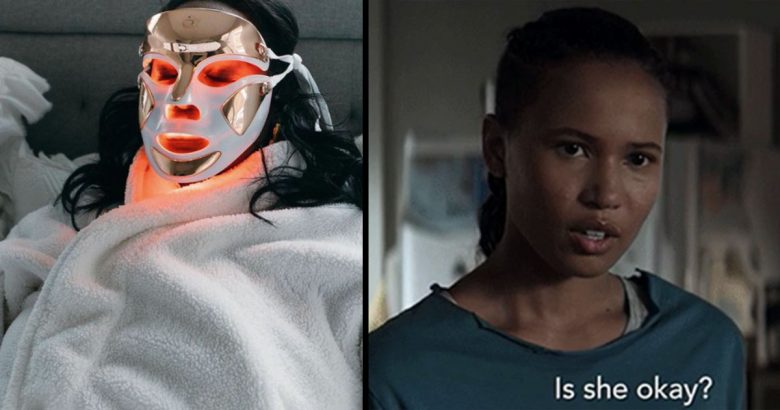
We Got A Skincare Expert To Review Popular At-Home LED Masks
One minute you can be innocently browsing Instagram, eating M&Ms, and stalking your ex from 13 years ago — and next minute, you’re trapped in a never-ending vortex of sponsored beauty ads promising to give you clearer skin in just 15 minutes.
The M&Ms are suddenly thrown away. The ex, long forgotten. Australia’s lockdown put to the back of your brain for two blissful seconds.
Anti-ageing and clear skin in the safety of my home? Tell me MORE.
LED treatments haven’t been something I’ve given much thought to in the past. However, Stefan Mazy, the founder of SkinDNA, is a big advocate of professional LED treatments. After I had a consult with him recently, one thing that stood out to me was my previous misconception of LED treatments. I had used LED light therapy in the past, after skin needling sessions, and had an Omnilux treatment after a HIFU session, but I’d never considered LED as something I should be doing at home or on a regular basis as I age. Let’s just say Stefan put things into perspective for me:
“A lot of people visit their cosmetic clinics with the belief of no pain no gain,” he said. “So too often we see patients wanting laser treatments, intense chemical peels and basically anything that can either strip skin or inflict some sort of pain or discomfort. It’s human nature to believe that if we feel something it has to be working.
“When we talk about LED, you sit in front of some light for a few minutes, you feel nothing, and your treatment is over. I understand that it’s not a popular choice but hear me out: when it comes to professional LED treatments it’s best to know the science before undergoing a treatment. You will then appreciate what is actually happening within your skin. Once I explain the science it’s very easy to convert people to into LED believers,” he said.
So what does a skincare expert think about at-home LED masks? We asked Stefan Mazy of SkinDNA to break down whether at-home LED masks really do work.
View this post on Instagram
Firstly, why should we consider at-home LED devices?
“When we talk about at-home LED, not all devices are the same. When finding an at-home device it’s always important to look for the nanometer penetration (nm) and also understand what you are wanting to achieve. Different colours produce different wavelengths and have different benefits such as collagen production, cellular energy, redness reduction, bacterial and acne.
The main difference between at-home and in-clinic are the dose (joules) and the power density (milliwatts). Best way to think about it is the higher the power the shorter the treatment the higher the density the better the surface exposure on the skin. Dose and power can be a dangerous thing in the wrong hands. Think of you’re at home IKEA drill you purchased – you don’t see professional builders at construction sites using them.
For safety reasons a lot of at-home devices have reduced power quite simply because people would overuse them and cause more damage. This doesn’t mean at-home LED masks are not good, in fact, they work great and are often used in conjunction with visiting your skin clinic.”
In your opinion, what brands are doing a good job of at-home LED masks?
Best all rounder: Dr Gross
“The dosage is the highest and as a result, the treatment length is shorter (3 minutes). The power is lower, however when deciding on a device you need to take into consideration the wavelengths, the power and the dose.”
Best for anti-aging: Omnilux
“It brings to your home professional and peer-revied LED technology specifically for anti-aging.”
Best “something is better than nothing”: PeppyCo
“While the power and dosage are not disclosed. Based on the treatment length, the specific wavelengths they use and the price point I would say this would be a good starter product. It would be useful to see if you have the ability to follow an LED routine. Why spend $600 if you’re not sure if you can actually have what it takes to follow regular treatment routine!”
View this post on Instagram
A proper breakdown of the popular LED masks on the market, according to SkinDNA’s Stefan Mazy.

Brand one: PeppyCo, $163, 10-20 minute sessions
“PeppyCo uses 3 different colours:
Yellow: It is programmed to 590nm. This has been proven to pause a gene called MMP that is directly responsible for excess collagen breakdown.
Red: 630nm has been shown to act as an anti-inflammatory and heal inflamed skin.
Blue: 470nm has been shown to reduce acne-causing bacteria.
These are all big ticks in my books however the company does not disclose the dose and power. Based on the price point, it is likely that the power parameters are low and as a result, in order to get meaningful results you may need to wear the mask for a lot longer than recommended.”
Brand two: Omnilux, $550, 10 minute sessions
“Dr Glen Calderhead is considered the pioneer of commercial LED technology. I had the privilege of having coffee with him while we were both speaking at a symposium in the UK a few years ago – He is a world of knowledge.
While Dr Calderhead has left the company, Omnilux has become a staple in a number of clinics around the world. Omnilux has a new at-home face mask that uses the same wavelength as their professional Revive™ treatment.
Omnilux Contour Face is similar to its professional device whereby it combines two wavelengths together – something that the other brands do not do. The two specific wavelengths are 633nm and 830nm. It does not claim to help with bacteria causing acne however by combining both wavelengths has been shown to help improve sun damage, increase cellular production and improve cellar energy. These claims are supported by scientific literature.”
Brand three: Dr Dennis Gross, $619, 3 minute sessions
“This is one of the pricey mask options and uses red light and blue light – 415nm blue light – great for acne and flareups, and 633nm red light – increases collagen and been proven to pause a gene called MMP that is directly responsible for excess collagen breakdown.”
Brand four: Aduro, $499, 20 minute sessions (but based on power output Stefan would recommend shorter treatments of 5-10 minutes).
“I’d classify this the rainbow mask because it has 8 different colour wavelengths. While I am a fan of LED it’s also not the holy grail and even though there is some research to support different colours being beneficial it is unlikely that a person would use every colour offered.
While this mask packs a lot of power it does not appear to be as efficient in its dosage in comparison to others.”
Brand five: Socialskin Co, $99, 15-30 minute sessions
“This is a great example of the power of social media. This is a great looking device and if this is the future of at-home LED then sign me up. The mask uses red, blue and yellow lights. Other than a great looking product the company lacks the technical side.
However, based on the recommend session times it would be fair to assume the dose and power would be on the lower end and its futuristic look is probably best used as a great dance party accessory.”
On further at-home skincare treatments that can enhance LED
“Skin needling is a great at-home treatment for those who are missing laser and collagen production treatments. I would advise against anything longer than 0.5mm,” Stefan told us. “Skin needling creates micro-wounds within the skin that triggers inflammation and inflammation triggers collagen production. By doing this 2-3 times a week will help keep your skin fit and firm. In addition, it increases blood flow to the skin so will help give you a healthy glow.”
Stefan also recommended while we’re stuck at home more often to get a good Hyaluronic Acid serum. “Being inside all day longer than normal it is likely your skin will suffer from abnormal dryness and dehydration. Hyaluronic can help provide nourishment and hydration. It’s something everyone should use,” he said.
And he’s also a big believer in getting some vitamin D.
“Sit on your balcony and have your coffee. That 10 minutes can change your skin complexion, improve your mood and allow your body to produce amongst other goodness, vitamin D,” Stefan explained.
View this post on Instagram
